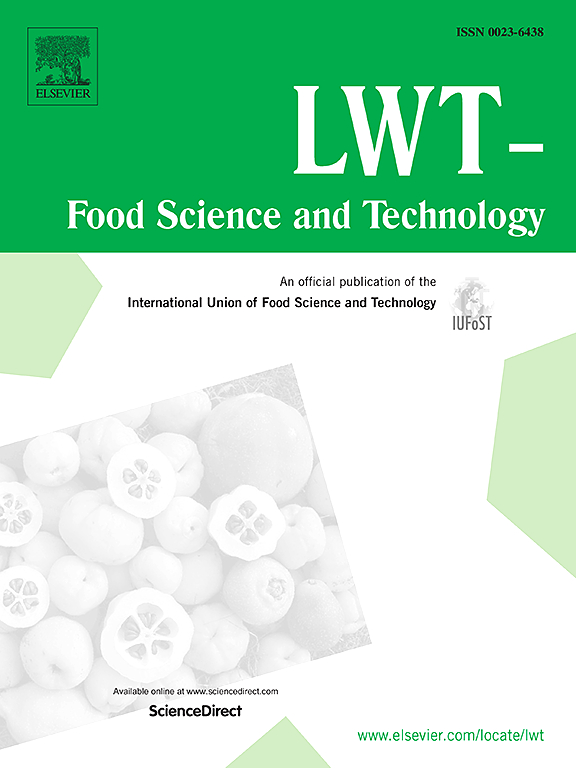Effects of combining ultrasound and dual enzymolysis with hydroxypropylation, acrylate grafting, or phosphate grafting on the physicochemical and functional properties of oil palm mesocarp expeller dietary fiber
IF 6.6
1区 农林科学
Q1 FOOD SCIENCE & TECHNOLOGY
引用次数: 0
Abstract
Oil palm mesocarp expeller is an abundant and low-cost dietary fiber resource, but its poor hydration and adsorption properties limit its utilization in foods. Therefore, ultrasound and enzymolysis combined with hydroxypropylation, acrylate grafting, or phosphate grafting were used to improve the adsorption properties of oil palm mesocarp expeller fiber (OPMEDF) for the first time. The results revealed that these composite modifications made the microstructure of OPMEDF more porous, and significantly increased its soluble fiber content, surface area, hydration properties, and sorption abilities of glucose, nitrite, copper, and lead ions but decreased its brightness. OPMEDF modified by ultrasound, enzymolysis, and acrylate grafting had the highest content of extractable polyphenol and sorption abilities on oil and nitrite ion. OPMEDF subjected to ultrasound, enzymolysis, and phosphate grafting showed the highest water-swelling volume (3.84 mL g−1) and sorption abilities of copper (II) and lead (II) ions. Notably, OPMEDF modified by ultrasound, enzymolysis, and hydroxypropylation exhibited the highest soluble fiber content (14.72 g∙100 g−1), water-retention ability (5.22 g g−1), viscosity (13.90 cp), and glucose adsorption capacity (38.18 g∙100 g−1). These results indicated that these composite modifications are good options to improve the adsorption capacities of OPMEDF and can expand its potential hypoglycemic and hypolipidemic effects.

超声波和双酶解与羟丙基化、丙烯酸酯接枝或磷酸酯接枝相结合对油棕中果皮剥离膳食纤维的理化和功能特性的影响
油棕中果皮果穗是一种丰富且低成本的膳食纤维资源,但其水合和吸附性能较差,限制了其在食品中的利用。因此,研究人员首次采用超声波和酶解法结合羟丙基化、丙烯酸酯接枝或磷酸酯接枝来改善油棕中果皮榨油纤维(OPMEDF)的吸附性能。结果表明,这些复合改性使 OPMEDF 的微观结构更加多孔,显著提高了其可溶性纤维含量、表面积、水合性能以及对葡萄糖、亚硝酸盐、铜和铅离子的吸附能力,但降低了其亮度。经超声波、酶解和丙烯酸酯接枝改性的 OPMEDF 的可提取多酚含量最高,对油和亚硝酸盐离子的吸附能力也最强。经超声波、酶解和磷酸酯接枝改性的 OPMEDF 的水膨胀体积(3.84 mL g-1)最大,对铜(II)和铅(II)离子的吸附能力也最强。值得注意的是,经超声波、酶解和羟丙基化改性的 OPMEDF 表现出最高的可溶性纤维含量(14.72 g∙100 g-1)、保水能力(5.22 g g-1)、粘度(13.90 cp)和葡萄糖吸附能力(38.18 g∙100 g-1)。这些结果表明,这些复合改性是提高 OPMEDF 吸附能力的良好选择,可以扩大其潜在的降血糖和降血脂作用。
本文章由计算机程序翻译,如有差异,请以英文原文为准。
求助全文
约1分钟内获得全文
求助全文
来源期刊

LWT - Food Science and Technology
工程技术-食品科技
CiteScore
11.80
自引率
6.70%
发文量
1724
审稿时长
65 days
期刊介绍:
LWT - Food Science and Technology is an international journal that publishes innovative papers in the fields of food chemistry, biochemistry, microbiology, technology and nutrition. The work described should be innovative either in the approach or in the methods used. The significance of the results either for the science community or for the food industry must also be specified. Contributions written in English are welcomed in the form of review articles, short reviews, research papers, and research notes. Papers featuring animal trials and cell cultures are outside the scope of the journal and will not be considered for publication.
 求助内容:
求助内容: 应助结果提醒方式:
应助结果提醒方式:


